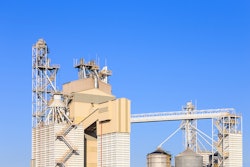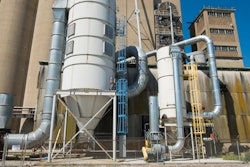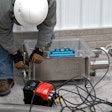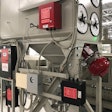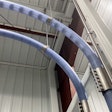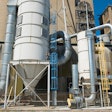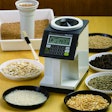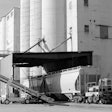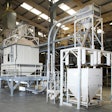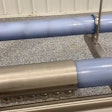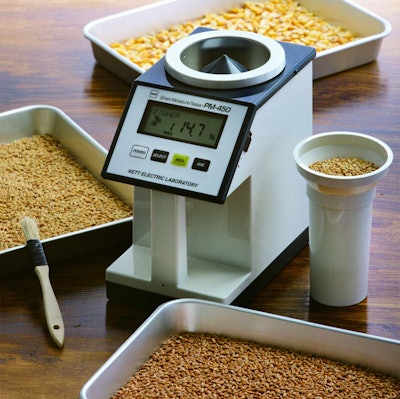
Not too long ago, a feed mill in Weimar, TX, caught fire due to a spark from an overheated bearing in one of the mill’s elevator legs.
This led to a dust explosion that could be heard from miles away. It is a cautionary tale for anyone handling grain or feed that requires heating and drying before storage.
Over-drying grain is dangerous
Over drying grain before storage, whether corn, wheat, oats, rice, sorghum, millet, rye or barley, can leave it more susceptible to catching fire whenever a spark occurs, whatever the source.
The ignition can come from the crop itself, or from any dust generated during handling and processing.
These kinds of fires inevitably lead to a loss of valuable grain, production, and equipment – which can be difficult to recover from financially.
While the danger of a fire during grain drying is a major issue, the financial impact of not sufficiently controlling moisture can also be ruinous.
“Preparing grain for storage can be tricky when achieving the right moisture level is necessary," said John Bogart, managing director of Kett US, a manufacturer of a full range of moisture and organic composition analyzers.
"Too dry, and sellers not only increase the risk of fire but also miss out on profits when grain is sold by weight. Too moist, and stored grain can quickly spoil, leaving that entire portion of the harvest unsellable, leading to a major loss of income."
Fortunately, a variety of very reliable, accurate, and easy to use moisture meters is now available that will allow grain processors to dry grain for storage at precisely the right moisture levels.
Providing desktop, inline and portable models, the moisture meters can not only minimize the risk of fire and over drying but also maximize profit, quality, weight, and sales price by eliminating under drying.
These instruments use either electrical methods (capacitance, conductance, radio frequency “RF”) or near infrared (NIR) technology.
Reliably determine moisture levels
Drying grain to the correct moisture level is a delicate balance that requires an accurate moisture meter and frequent checking to avoid both over and under drying.
For example, wet corn can be stored briefly but needs constant monitoring. Such storage is meant as a stop-gap while harvesters wait for a drying backlog to clear, according to Bogart.
“During this time, the bin needs regular aeration, and grain processors should look for trouble signs such as hot spots, foul odors, or visual spoilage. The wet corn needs to be stored at the lowest possible temperature to prevent microbial growth,” he says.
During wet seasons, farmers usually do not have much choice besides sending their harvest through a grain dryer.
Leaving the grain unharvested in the field can lead to an increase in field losses, which can quickly escalate. Harvesting crops in November can create field losses between 3% and 5%.
Leave the crops unharvested until December, however, and the field losses increase to a crippling 22% thanks to weather-related issues, wildlife damage and disease pressure.
The dangers of grain drying
Wet crops going into grain storage are often left with one viable option: grain dryers. Fires occur in grain dryers too often, however, and the damage can be extensive.
When waiting for grain to fully dry, monitoring changes in moisture level is necessary to prevent elevated fire danger as well as over drying.
This can be particularly important when drying high-moisture corn since outside screens can quickly accumulate debris, raising the fire risk.
How to accurately measure moisture in stored grain
When monitoring changes in moisture content during grain drying, it is vital to keep certain points in mind to prevent inaccuracy.
For instance, do not handle samples with an uncovered hand, which can add moisture.
For the same reason, do not leave samples in an open container, which can expose them to moisture absorbed from the air.
Selecting the right moisture meter
Fortunately, a variety of reliable moisture meters is available that facilitate accurate measurement.
When it comes to selecting a meter, the least expensive and most widely used instruments use the electrical methods.
These units generally come with standard product calibrations. An example is the Kett PM650, a portable unit that offers the farmer over 100 product calibrations.
Variations of the “electrical method” of moisture measurement contact gauges that utilize capacitance, conductance, radio frequency, and similar technologies.
These often provide less accurate readings than near infrared and loss-on-drying instruments.
This can become an issue when there are varying moisture levels within grain to be dried. So, it is critical to have an accurate moisture meter to limit drying times and prevent fires.
Not all moisture meetings are created equally
It is also essential to understand that at higher temperatures not all moisture meters automatically adjust to provide the most accurate moisture readings.
Advanced contact moisture meters can have accuracies of +/- 0.5% under normal operating conditions, but high drying temperatures can decrease the accuracy of some lesser units, according to Bogart.
“It is crucial to follow proper procedures for temperature corrections or use a moisture meter that automatically compensates for temperature fluctuations," he said.
For even higher quality measurements (as good as +/- 0.001%) continuous moisture testing instruments like Kett’s KB30 inline Near-Infrared (NIR) moisture meter can take instantaneous, accurate readings of conveyed grain at any temperature.
The instrument includes automatic temperature compensation, which means that users do not need to correct moisture readings for various ambient and/or product temperatures.
The benefits of near infrared (NIR) meters
NIR moisture meters follow the principle that water absorbs certain wavelengths of light.
The meter reflects light off the sample, measures how much light has been absorbed, and the result is automatically converted into an instant moisture content reading, explains Bogart.
According to Bogart, NIR meters allow very accurate instant measurement of any agricultural product without contact or sample preparation, so there is no contamination in online and handheld models.
“Once the meter has been calibrated against the lab or production standard, the calibration is stored in the device so no calibration is required in the field or drying facility,” he says.
Unlike air ovens or even moisture balances, portable NIR equipment is designed for ease of use.
With the most advanced units, the user simply points the instrument at the agricultural product. The moisture content is instantly shown on a digital display, with results accurate to .01% in a 0-100% measurement range.
Such units, which are about the size of a camcorder and operated via user-friendly menu commands, are designed for frequent spot checks wherever necessary on both stationary and moving products (i.e., conveyed into storage).
Moisture measurement data can be stored in the instrument, downloaded continuously or manually recorded.
“After bringing in the harvest, safely drying grain for storage and accurately measuring moisture content – neither too dry nor moist – will set up farmers to sell at the optimal weight, quality, and price in the market,” concludes Bogart.


